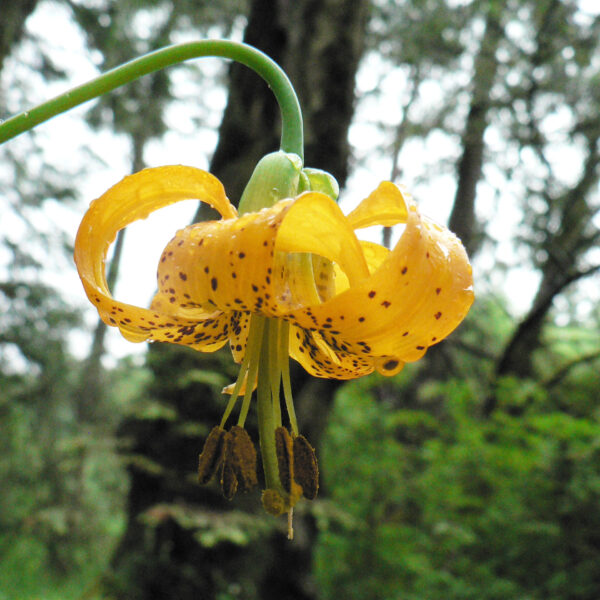Tiger Lily
Lilium columbianum Hanson ex Baker (L. canadense L. var. parviflorum Hook.)

overview
A tall perennial to 1 m, with a white ovoid bulb, up to 5 cm in diameter, composed of thick, fleshy scales, like garlic cloves. The stem is slender, with many whorls of narrow, lance-shaped leaves. The flowers are large, showy, bright orange, with deep red or purple spots near the centre, the petals curl backward. The flowers are few to many at the top of the stem. The seed capsules are oblong and tapered near the base (Douglas et al., 1991). Photo by Moralea Milne.
other names
Columbia lily, panther lily
family
Liliaceae
ecological setting
Western North American species found in damp open woods and meadows, from sea level to subalpine elevations. In British Columbia found throughout the province, south of latitude 54º N. Occurs in early seral communities on water-shedding, often colluvial, soils. (Klinka et al., 1995).
soil texture
Very well drained sandy soils that are rich in organic matter (Pettinger and Costanzo, 2002).
nutrients
Nitrogen medium soils (Klinka et al., 1995).
soil reaction salinity
Prefers rich acidic loam.
moisture regime
Well-drained, moderately dry to fresh soils (Klinka et al., 1995).
shade tolerance
Prefers a partly shaded site with shrub or perennial cover that will keep the soil cool and moist but allow the lily stalk to emerge into the sunlight.
successional status
Characteristic of open-canopy young seral forests (Klinka et al., 1995).
site rehabilitation
Not practical as a rehabilitation species.
wildlife
Not generally eaten by wildlife.
landscaping
Gives a lovely show in a herbaceous border as a background to lower growing plants (Pettinger and Costanzo, 1996).
first nations
Interior First Peoples ate the bulbs of the Tiger lily usually after being boiled or steamed for several hours (Douglas, Meidinger, Pojar, 1991).
flowering time
June to July
fruit ripening time
Late Fall
seed collection time
Late fall to early winter.
collection and abstraction
Seeds may be collected in the late fall after the plant has died back. The tapered oblong seeds may be found around the base of the plant.
seed storage
Not recommended.
fruit seed dormancy treatment
Sow seeds in the fall to allow dormancy to break naturally. This may not occur for two years as the seeds need multiple cycles of warm-cold-warm to trigger germination.
vegetative propagation
Successful propagation can be achieved by bulb division. Divide bulbs in the fall after the plant has become dormant. Bulbs should be taken from the wild only in salvage situations. Otherwise obtain plants or bulbs from a specialist nursery. Garden-grown bulbs can be divided in the fall or bulb scales used for propagation. Plant bulbs 5-7.5 cm deep in fall or early spring (Pettinger and Costanzo, 2002).
additional info and photos
For more information and pictures, visit the E-Flora BC website at www.eflora.bc.ca.